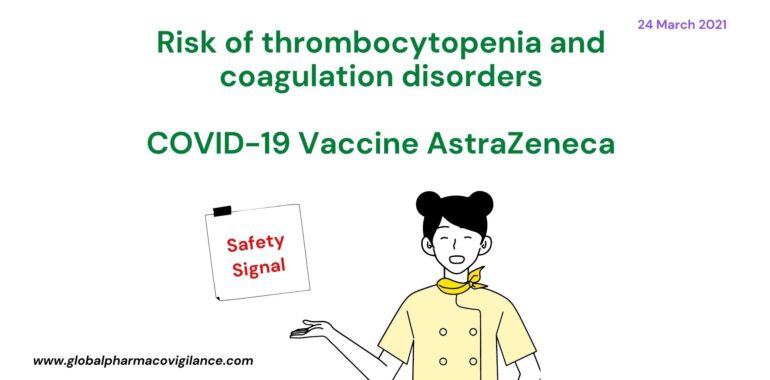Risk of thrombocytopenia and coagulation disorders with the use of COVID-19 Vaccine AstraZeneca

Risk of thrombocytopenia and coagulation disorders with the use of COVID-19 Vaccine AstraZeneca
Risk of thrombocytopenia and coagulation disorders with the use of COVID-19 Vaccine AstraZeneca
European Medicines Agency (EMA) has published Direct healthcare professional communication (DHPC) contains important information for healthcare professionals prescribing, dispensing, or administering the medicine(s).
DHPC also includes a communication plan with details of intended recipients and the dissemination date.
The DHPC is regarding “Risk of thrombocytopenia and coagulation disorders with the use of COVID-19 Vaccine AstraZeneca”.
Key facts of DHPC: Risk of thrombocytopenia and coagulation disorders with the use of COVID-19 Vaccine AstraZeneca
| Medicine name | Vaxzevria (previously COVID-19 Vaccine AstraZeneca) |
| Active substance | Chimpanzee Adenovirus encoding the SARS CoV 2 Spike glycoprotein (ChAdOx1-S) |
| Therapeutic area (MeSH) | COVID-19 virus infection |
| DHPC type | Safety signal |
| Date Dissemination | 24 March 2021 |
Vaxzevria is indicated for active immunisation to prevent COVID-19 caused by SARS-CoV-2, in individuals 18 years of age and older.
Vaxzevria (previously COVID-19 Vaccine AstraZeneca) is made up of another virus (of the adenovirus family) that has been modified to contain the gene for making a protein from SARS-CoV-2.
Vaxzevria does not contain the virus itself and cannot cause COVID-19.
Vaxzevria is given in two injections, normally in the upper arm muscle. The second dose should be given within 4 to 12 weeks of the first dose.
Summary of DHPC: Risk of thrombocytopenia and coagulation disorders with the use of COVID-19 Vaccine AstraZeneca
Healthcare professionals are reminded of the following in order to minimize the Risk of thrombocytopenia and coagulation disorders with COVID-19 Vaccine AstraZeneca.
Healthcare professionals should report any suspected adverse reactions associated with the use of COVID-19 Vaccine AstraZeneca in accordance with the national spontaneous reporting system
- COVID-19 Vaccine AstraZeneca: benefits outweigh the risks despite possible link to very rare blood clots with low blood platelets.
- A combination of thrombosis and thrombocytopenia, in some cases accompanied by bleeding, has been observed very rarely following vaccination with COVID-19 Vaccine AstraZeneca.
- Healthcare professionals should be alert to the signs and symptoms of thromboembolism and or thrombocytopenia.
- Those vaccinated should be instructed to seek immediate medical attention if they develop symptoms such as shortness of breath, chest pain, leg swelling, persistent abdominal pain following vaccination. Additionally, anyone with neurological symptoms including severe or persistent headaches and blurred vision after vaccination, or who experiences skin bruising (petechia) beyond the site of vaccination after a few days, should seek prompt medical attention.
DHPC Communication Plan: Risk of thrombocytopenia and coagulation disorders with the use of COVID-19 Vaccine AstraZeneca
| Medicinal product(s)/active substance(s) | COVID-19 Vaccine AstraZeneca suspension for injection (ChAdOx1-S [recombinant]) |
| Safety concern and purpose of the communication | Risk of thrombocytopenia and coagulation disorders |
| DHPC recipients | General practitioners and vaccination centres.
The target group should be further defined at national level, in agreement with the respective national competent authority. |
| Member States where the DHPC will be distributed | All EU member states where COVID-19 Vaccine AstraZeneca is marketed. |
Source from EMA site
Summary of the safety profile
- The overall safety of Vaxzevria is based on an interim analysis of pooled data from four clinical trials conducted in the United Kingdom, Brazil, and South Africa. At the time of analysis, 23,745 participants ≥18 years old had been randomised and received either Vaxzevria or control.
- Out of these, 12,021 received at least one dose of Vaxzevria and 8,266 received two doses. The median duration of follow-up was 62 days post-dose 2.
- The most frequently reported adverse reactions were injection site tenderness (63.7%), injection site pain (54.2%), headache (52.6%), fatigue (53.1%), myalgia (44.0%), malaise (44.2%), pyrexia (includes feverishness (33.6%) and fever >38°C (7.9%)), chills (31.9%), arthralgia (26.4%) and nausea (21.9%).
- The majority of adverse reactions were mild to moderate in severity and usually resolved within a few days of vaccination. When compared with the first dose, adverse reactions reported after the second dose were milder and reported less frequently.
- Reactogenicity was generally milder and reported less frequently in older adults (≥65 years old).
- The safety profile was consistent across participants with or without prior evidence of SARS-CoV-2 infection at baseline; the number of seropositive participants at baseline was 718 (3.0%).
CONCLUSION: COVID-19 Vaccine AstraZeneca benefits outweigh the risks despite possible link to very rare blood clots with low blood platelets.
To know more information (Risk of thrombocytopenia and coagulation disorders with the use of COVID-19 Vaccine AstraZeneca), Click here.
Top articles related to Covid-19 Vaccines.
Oxford-University-Astrazeneca-covid-19-vaccine-safety-data
Pfizer-biontech-covid-19-vaccine-safety-data
FDA-briefed-moderna-covid-19-vaccine-safety-data
Safety concerns-of Covid-19 vaccines
I go to see every day a few web sites and information sites to read articles, except this blog provides quality based content.